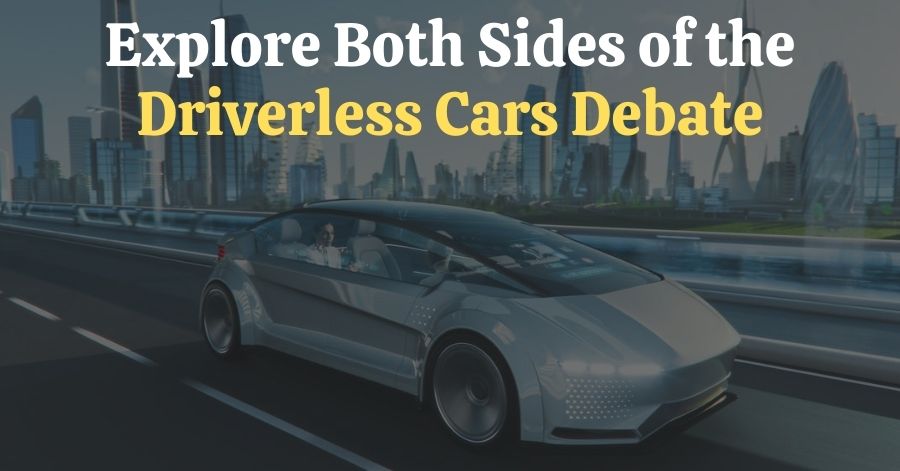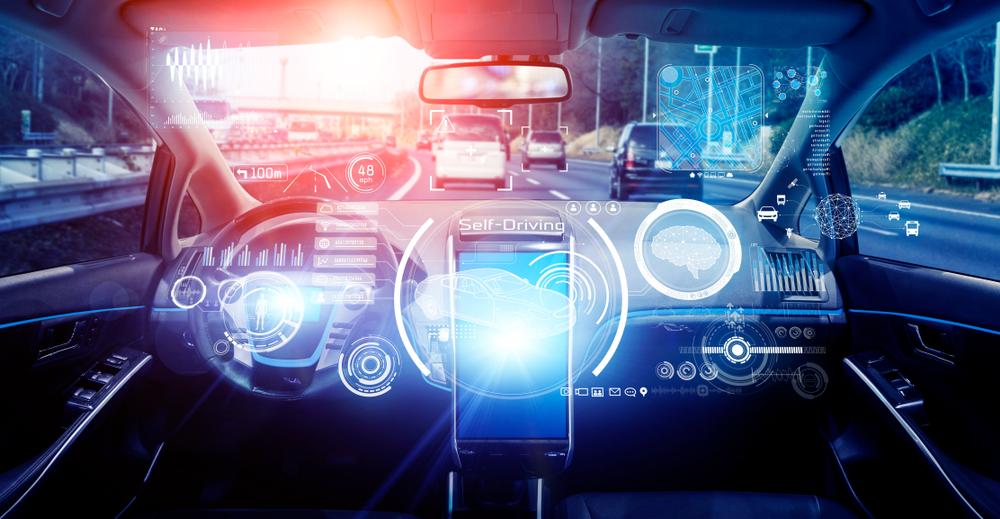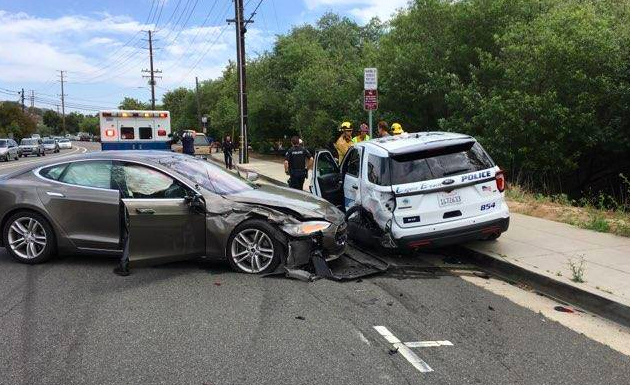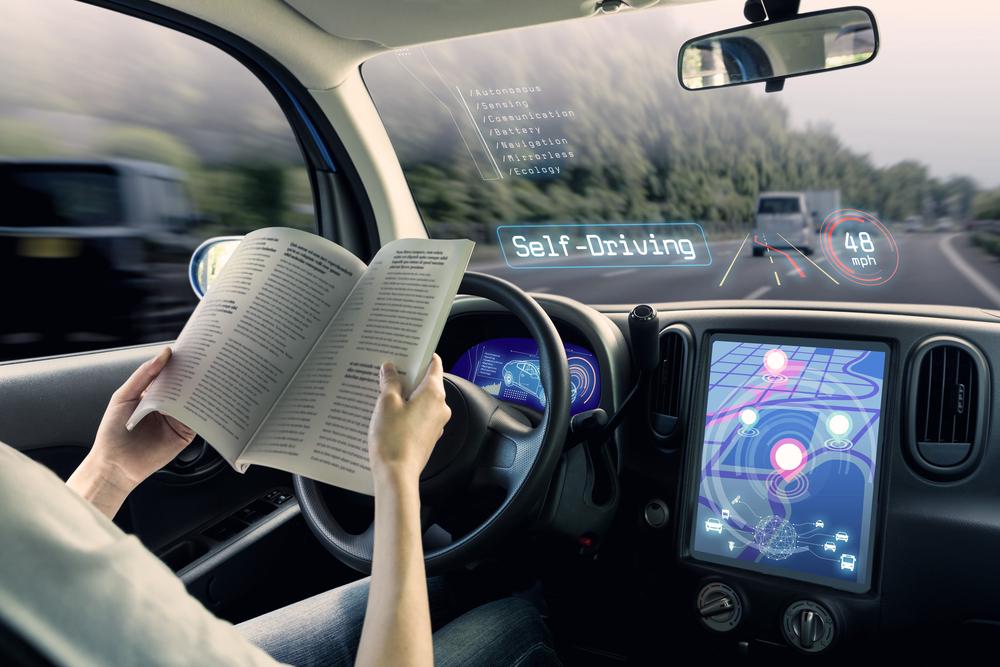
The gas vs. electric car debate can overshadow the presence of an arguably more important topic of driverless or autonomous vehicles. Automotive manufacturers have been making strides toward autonomous vehicles with semi-autonomous technology that comes as standard or available features.
You might recognize these semi-autonomous features found within today’s new models:
- Rear-park assist with cross-traffic alert
- Pedestrian detection with automatic braking
- Blind Spot Alert
- Lane Keep Assist
These are merely a small handful of current semi-autonomous features acting as a testing ground for a more sizable vision of 100% autonomous driving. The list of features above falls into the driving safety category and utilizes radar technology, cameras, and other components to keep drivers one step ahead of the unpredictable in the most convenient manner possible.
Automotive companies like Chevy are already taking larger steps toward autonomous driving with features like Super Cruise. Slide behind the wheel of a Cadillac Super Cruise programmed vehicle, and you’ll experience the first complete hands-free driving assistance program that’s accessible on compatible roads. Cadillac has already mapped out over 200,000 miles of roads throughout the U.S. and Canada, leading to more than 7 million miles of Cadillac customer hands-free driving. Lane Change on Demand, automatic safe distancing, and hands-free steering help Super Cruise establish its innovative autonomous presence.
A Cadillac’s Super Cruise technology primarily uses:
- Real-time cameras
- GPS
- Sensors
- LiDAR precision map data
Let’s take this topic one step forward by accessing the pros and cons of 100% autonomous cars.

Pro #1: Do Autonomous Vehicles Reduce Accident Rates?
It’s natural to worry about a self-driving car getting you into an accident due to a malfunction. You can mitigate your fear of autonomous accidents by understanding that over 90% of automotive accidents result from human-induced errors. Any accidents generated by a self-driving car would exist at a far lower rate than vehicles led by humans.
An autonomous car’s ability to drastically lower the likelihood of an accident is based on the vehicle’s sensory technology that extends beyond a person’s standard field of vision. This programmed vision can recognize more subtle environmental elements that a human might miss.
Road rage generates a lot of accidents. Driverless cars would radically lower or eliminate the presence of road rage so our roads could be paved with higher levels of safety.
Distracted driving similarly acts as a catalyst for automotive crashes. Whether a person is tired or texting, an autonomous car would pay attention for them.

Pro #2: Are Driverless Cars Environmentally Friendly?
Traffic jams increase our greenhouse gas emissions since vehicles are idling or driving at stop and go rates. Most self-driving cars are going to be electric or hybrid models. A Future of Driving report predicts that these new-age cars will help cause a 60% reduction in emissions. These environmental benefits would subsequently benefit the entire ecosystem and not just humans.

Pro #3: How Would Autonomous Vehicles Make Driving More Accessible?
Autonomous vehicles give people who usually can’t drive the opportunity to comfortably experience the benefits of automotive travel. These demographics might include the elderly or people with disabilities. While public transportation can play a similar role, every region doesn’t have a quality public transportation system that’s accessible and reliable.
Pro #4: What Cost Savings Are Associated with Driverless Cars?
Car crashes place a significant strain on our economy with factors like repair costs, the need for additional healthcare, and higher insurance fees. It’s estimated that self-driving vehicles can help save us around $800 billion with perks increased fuel savings. As time progresses, more autonomous competitors will enter the picture and offer lower-priced self-driving cars, while expensive programs like driver license tests will decline in cost.
Pro #5: Do Autonomous Cars Boost Driving Efficiency?
Human driving errors often generate traffic jams that cause higher fuel consumption rates due to heavy acceleration and braking. Autonomous cars are designed to communicate with each other to travel seamlessly at appropriate distances from each other. This technological communication could lead to your vehicle taking an alternate route that’s faster while you read emails, catch up on your favorite entertainment, or talk on the phone.
Behind the wheel, fatigue becomes increasingly likely when you’re embarking on an extensive driving journey. A self-driving car can allow you to take a short nap while you simultaneously make good time toward your destination. Manufacturers are already combatting the risks of driving fatigue through semi-autonomous technology features that sense distracted driving and send alerts to a driver.
Many drivers have experienced instances where we miss a driving turn or exit, especially when navigating territory that we don’t frequently visit. An autonomous car would keep you one step ahead of turns and exits leading to point B.
Pro #6: How Would Driverless Cars Create Time Savings?
A lot of automotive accidents happen due to a driver’s attempt to shave time off their journey. A self-driving car could allow you to hop out in front of your destination while the car takes care of parking itself—naturally saving you time and stress. Other risky timesaving driving instances can include a person speeding to their destination. Proponents of autonomous vehicles have pointed out that these cars will be able to travel at increased speeds due to their higher levels of driving efficiency.

Pro #7: Will Driverless Cars Positively Impact the Police?
Police spend a lot of their time and energy addressing vehicle mishaps. Lower auto accident rates through autonomous driving can allow police to focus their attention on other pressing issues.
Pro #8: Do Autonomous Cars Produce New Job Opportunities?
While it’s true that driverless cars would eliminate certain types of jobs, they can also generate new jobs. We’re going to need people to perfect this new type of driving, both on the manufacturing end and the programming end.
Pro #9: Are Driverless Cars Less Prone to Theft?
It’s naturally going to be more difficult to break into a self-aware vehicle. Think about our use of smartphones. Many types of smartphones contain facial and fingerprint recognition technology for additional security. We can move these types of advanced security measures into autonomous vehicles to lower instances of car theft.
Con #1: Could Autonomous Hacking Become a Problem?
Self-driving cars open the door to hacking opportunities with their use of sensors and signals that communicate with external reception points. Hackers may use autonomous driving as an opportunity to facilitate glitches and errors that lead to accidents.
Even if you’re not worried about autonomous driving hacking, you may be concerned about your car’s need to collect your personal information. Autonomous car manufacturers would most likely need to adhere to privacy protection measures so their drivers could achieve more peace of mind. Without these protections, a manufacturer could hypothetically sell your data to a third party.
Con #2: How Much Will Driverless Cars Cost?
A transition to driverless cars is going to cost a lot of money. To begin, initial self-driving models are going to be expensive due to a lack of competition and the technology being in its early stages. This high price is going to result in a lack of accessibility that will slow the transition rate. Governments will then have to implement new infrastructure to support autonomous vehicles, which will result in plenty of time and money being spent.
Con #3: Will Autonomous Accidents Be Worse Than Human Accidents?
Accidents are most likely the most significant fear linked to the gradual emergence of autonomous driving. Much of the public’s worry is associated with the unknown consequences of self-driving car glitches. These hiccups may result in worse automotive accidents than if a human had been driving the car.

All the safety benefits reported with autonomous driving are only entirely possible once we switch completely to self-driving vehicles. Until that complete transition is accomplished, autonomous cars will undoubtedly get into accidents with human-led cars.
You might be wondering who’s responsible if an autonomous car gets in an accident. We’re wondering the same thing. This conundrum is a significant hitch that the self-driving vehicle industry will have to work out.
Adherence to local traffic rules helps lower the chances of an accident taking place. Autonomous cars may have difficulty recognizing and following certain local traffic regulations. These lower levels of recognition may be perpetuated when driverless cars drive within inclement weather like rain or snow. These disruptions have occurred when the snow has blocked autonomous sensors and rain has interrupted roof-mounted laser sensory technology.
The bottom line with this driverless vehicle safety problem is our lack of understanding of how humans can respond if something goes wrong. It would be helpful if a responsibly chosen organization could oversee autonomous vehicle maintenance, so these models could consistently operate to the best of their abilities.
Con #4: Will Our Driving Skills Diminish?
There’s a reason why people occasionally make jokes about New Yorkers who transition from walking and public transportation to driving a car. Operating a vehicle is a skill that takes practice. If you take prolonged time off from driving, your abilities behind the wheel will naturally decline. Humans may feel less confident about taking command of an autonomous car if something were to go wrong with this driving inaptitude.

Con #5: Would Autonomous Cars Produce More Congestion?
There’s a counterargument to the assertion that self-driving cars’ efficiency facilitates lower levels of traffic. As the self-driving car movement progresses, it’s reasonable to think that the number of vehicles on the road would increase with formerly restricted drivers like the elderly and disabled on the road—subsequently causing more traffic pileup.
Con #6: Do Driverless Cars Negatively Impact the Job Market?
Rideshare service drivers and delivery providers would either be out of jobs or need to initiate major operational shifts to adapt to autonomous driving.
When Did Autonomous Car Development Begin?
You may be shocked to learn how far back the self-driving car movement dates. New York City’s 1939 World Fair featured a General Motors display that predicted the integration of autonomous cars by the late 1950s or early 1960s. This display contained an automated highway system that guided driverless cars toward their destination. General Motors ended up building a self-driving electric vehicle in 1939 that was led by radio-initiated electromagnetic fields.
Japanese automotive manufacturers took GM’s efforts on step further 20 years later by pioneering a 20-mph top-speed car that used camera systems to send data to an onboard computer that created driving responses. German vehicle makers increased this speed to 56 mph years later.

What Has Driverless Vehicle Development Looked like Recently?
August 2021 reports show that Google has begun testing its autonomous cars with participants in San Francisco. This is an excellent location for testing, given the city’s varied landscape that includes hills, narrow streets, pedestrian activity, and more.
It’s interesting but understandable that Waymo is banning its test participants from discussing the nature of their ride with anyone other than the self-driving project company. Test subject feedback is going to be an essential component of the autonomous initiative’s development phase. These test cars will have an operator in the driver seat with their hands on their knees—ready to take over if anything goes south.
It’s not a long shot for fully autonomous cars without a steering wheel or accelerator to make a 2025 debut. We can see that the auto industry has been experiencing more changes now than it has in decades.
How Do You Feel about Autonomous Cars?
While our list has more pros than cons associated with driverless cars, the cons are significant enough to make continuous autonomous vehicle research and development a vital initiative. Feel free to share your opinion of driverless vehicles in A1 Auto Transport’s social media feed’s comment section to expand the conversation.






 Share on Facebook
Share on Facebook Share on LinkedIn
Share on LinkedIn Share on Twitter
Share on Twitter




 Google
Google  Instagram
Instagram  Trustpilot
Trustpilot 



